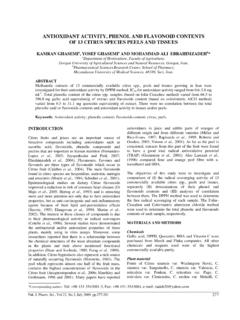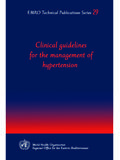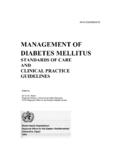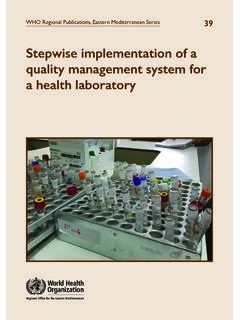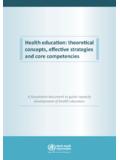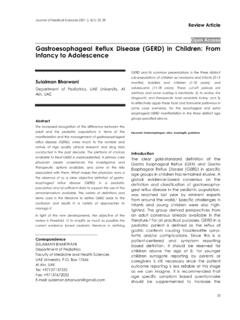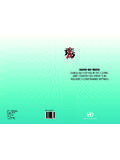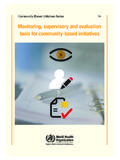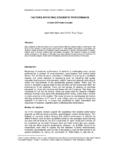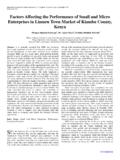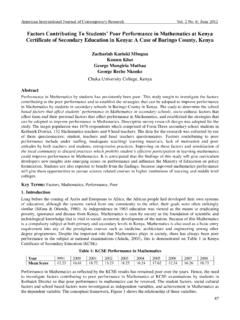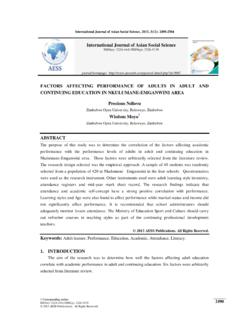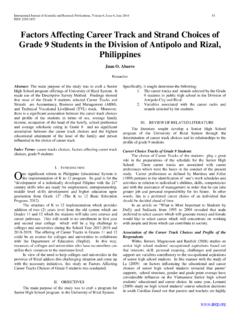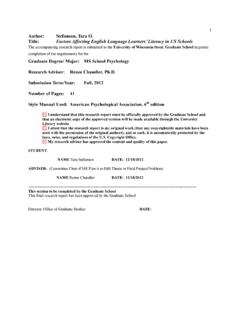Transcription of Factors Affecting Academic Performance of …
1 Pakistan Journalof Medical Research, 2013 (April- June)47 Pak J Med , , 2013 Factors Affecting Academic Performance of PrimarySchool ChildrenSultana Habibullah, Junaid AshrafPMRC Research Centre, Dow Medical College, :To determine the socio-economic, psychosocial, environmental and student related Factors Affecting academicperformance of public and private primary school type, settings and duration:Descriptive cross-sectional survey of 600 students (300 each from public and privateprimary schools) using randomly selected children from Saddar town, Methods:Using selected schools and children, information was collected on a questionnaire.
2 The factorsstudied included socio-economic, psychosocial, school and home environment and student related Factors . SPSS version 15was used for data analysis and chi-sq at alpha level for significance test. Univariate and multi variate analysis wereused to find out the association of the :A total of 600 students filled the questionnaire of whom 300 were from private and 300 from public sectorschools. The mean age of children was with male to female ratio of 1 in public schools and 1 in privateschools. Socio-economic status was classified as good, fair and poor using the parent s job and number of family membersworking.
3 Almost 34% children belonging to public and 65% to private schools were categorized as thepublic school children 65% fathers and 58% mothers were literate while, these figures were 62% and 67% among privateschool children. Overall 25% school children did not regularly take breakfast. Almost 50% public and 20% private schoolchildren remainedabsent once a week. Overall 35% childrendid not have adequate sleep and 22%children of public and14% of private schools were suffering from some kind of illness. Based on BMI overall 24% children were underweightwhile, obesity was seen in 3% public and 11% private school students.
4 Parent s help in completing school homework wastwice more in those studying in private school (11% public and 22% private) thus showing a better Academic performanceof students in private school (poor Performance seen in 40% public and 16% private).Cognitive behavior evaluated fromlearning habitsand overall psychosocial condition was good in both types of school children and school environment of43% public and 54% private school was also good. Majority of the schools had no sports or physical training univariate and multivariate analysis it was found that younger age, female gender, better socio-economic condition,habit of taking breakfast, better condition of school, and regular attendance were significantly associated with betteracademic : Academic Performance of public school children was poor as compared to private schools.
5 Socio-economic,psychosocial, school and home environment and student s own Factors , affected their Academic message:School and out of school Factors both need to be improved for achieving good school achievement ofprimary school words:School achievement, socio-economic condition of families, sib size, psychological condition, school and homeenvironment, health, diet, sports, leisure time actives, learning children are pressurized to learn more inschools and improve their abilities to read writeand apply solution of problems in order to pass asuccessful and comfortable life1.
6 Attempts to improveacademicperformanceinschoolinclud ehighexpectations, task on time, safe climate and challengingcurriculum. Schools are often blamed for student s pooracademic Performance despite the fact that teachers andprincipal work hard to provide strong curricula, highexpectations and safe climate2. Academic Performance isaffected by many Factors which included prenatal, nataland postnatal issues of the mother apart from nutritional,socio-economic and environmental factors3,4. Childrenwho do poorly at school may be under a lot of stress andcope with it either by externalizing their feeling asbehavior problem while, others might internalize it andpresent with daily headache or stomachache5.
7 It isgenerally perceived that there are two groups of students,one who can improve and another who do not Author:Sultana HabibullahPMRC Research CentreDow Medical ArticleSultana Habibullah, Junaid AshrafPakistan Journalof Medical Research, 2013 (April- June)48 Trend towards education in Pakistan is growingbut the effect of socio- demographic profile of the family,eating habits, recreation and school environment on theacademic output of these children has not been of these Factors and their solution is likelyto improve the yield of these youths.
8 The present studywas done to compare the socio-economic, psychosocial,environmental (school and home) and student s relatedfactors Affecting Academic Performance between publicand private primary school and MethodsThis was a cross-sectional descriptive sample size of the study was 600 primary schoolchildren, calculated by taking anticipated populationproportion of 50% at confidence interval of 95% andrelative precision of 4% of a total of 600 children, 300 were selectedfrom 14 public schools and 300 from 11 private schools were selected randomly from 10 UnionCouncilsof Saddar town.
9 Students of class five who were present at theday of interview and were fit for interview were includedin the included socio-economic status which,was assessed by number of parents employed and their jobtype. Psychosocial Factors were evaluated by the interest inattending school, mood type, any feeling of loneliness,confidence, anxiety or angriness. Environmental factorsincluded both school and home environment. Schoolenvironment variables included condition of schoolbuilding, class room size, availability of ventilation andsunlight or electricity and fans, school furniture,surrounding noise and teacher student ratio.
10 Homeenvironment variables included number of brothers/sistersliving with them, parental education, involvement ofparents in student s homework. Student s Factors includedphysical health/illness, physical training/sports activities,leisure time activities, school attendance, diet/nutrition,learning skills, sleep/rest hours, healthy habits like handwashing, brushing teeth. Health indicator used wascalculation of Body Mass Index (BMI). Dependentvariable included students grade/score obtained in last yearannual was collected using aquestionnaireand an assent form was developed for students inUrdu/English where they were asked to write their name ifthey agreed to participate in the study.
